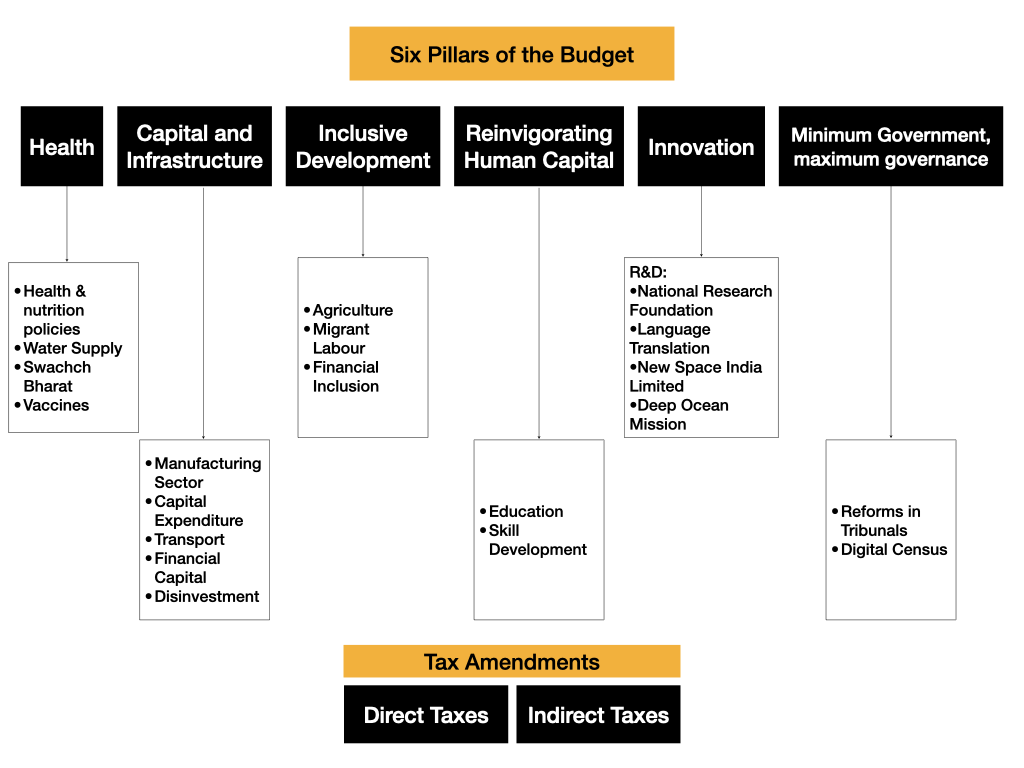On February 1, 2021, Finance Minister Nirmala Sitharaman presented the Union Budget 2021-22 in the Parliament. The first paperless budget of the country, it shoulders an additional significance as it includes measures to recover from the havoc wreaked by the pandemic.
Here are some key figures.
- The government proposes to spend Rs 34,83,236 crores in 2021-22.
- Estimated fiscal deficit of 6.8% of GDP compared to last year’s estimated deficit of 9.5%. The fiscal deficit is the difference between revenue receipts plus non-debt capital receipts and total expenditure. Essentially, it indicates how much a government needs to borrow (through the issue of securities and Treasury Bills) in order to fund public services and other benefits.
- Capital expenditure targeted at Rs 5.54 lakh crore compared to 2020-21’s Rs 4.39 lakh crore. Capital Expenditure is the money spent on acquiring assets such as land, buildings, machinery and investment in shares.
- Disinvestment target set at Rs 1.75 lakh crore. Disinvestment is the sale of government assets, usually public sector undertakings, allowing more private participation.
- Rs 35,000 crores additionally allocated for COVID-19 vaccines.
The following flowchart is a visual representation of the different areas addressed in the Union Budget 2021-22.

We’ve covered some sections that impact us as global learners and job seekers.
- Education and Skill Development
- Research and Development
- Capital and Infrastructure
- Health
- Some Tax Amendments
- The National Research Foundation has been allocated Rs 50,000 crores for a period of five years. This foundation will spearhead the development of a research ethos in the country and thrust forward disciplines of national priority.
- The budget also emphasizes a translation mission that will allow governance and policy related material on the internet to be available in all major Indian languages.
- The budget provides for the New Space India Limited (NSIL), a PSU under the Department of Space that will execute the PSLV-CS51 launch, carrying the Amazonia Satellite from Brazil, along with a few smaller Indian satellites.
More than Rs 4,000 crores, spread over a span of five years, is allotted for the Deep Ocean Mission. The premise of this project is to study and survey the depths of the ocean, aiming at the conservation of marine biodiversity.
This section of the article does not explore the specifics of various allocations done across industries for, it would go beyond the scope of this article. Rather, it summarises future trajectories that will impact the prospective jobseeker.
The budget adheres to what it calls a ‘Strategic Disinvestment Policy’ that minimises the role of the central government in public sector enterprises including financial institutions in order to create more investment opportunities for the private sector. Strategic disinvestment of BPCL, Air India, Shipping Corporation of India, Container Corporation of India, IDBI Bank, BEML, Pawan Hans, Neelachal Ispat Nigam limited among others would be completed in 2021-22. Other than IDBI Bank, two public sector banks and LIC will also be partially privatised in the year 2022.
The private capital that comes in, along with competitive technology and management practices, will increase employment opportunities and eventually, contribute to economic growth. Essentially, the private sector is taking the lion’s share of the nation’s economy. It comes with its advantages and disadvantages. As the market opens up for more private investors, it increases the number of players in any given industry which means more jobs will be created.. On the other hand, competition increases and profit becomes the key determinant of survival








![Best Universities in New Zealand for International Students [2025 Rankings]](https://tcglobal.com/wp-content/uploads/2025/09/Best-Universities-in-New-Zealand-for-International-Students-2025-Rankings-600x338.png)